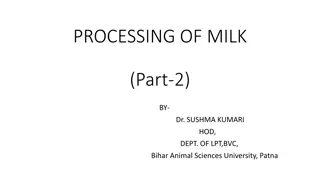
Leadership Theories: Trait Theory vs. Behavioural Theory
Explore the evolution of leadership theories, focusing on Trait Theory and Behavioural Theory. Trait Theory emphasizes specific traits of great leaders, while Behavioural Theory shifts focus to actions and behaviors. Learn about the strengths and weaknesses of Trait Theory in identifying universal leadership traits.
Uploaded on | 1 Views
Download Presentation

Please find below an Image/Link to download the presentation.
The content on the website is provided AS IS for your information and personal use only. It may not be sold, licensed, or shared on other websites without obtaining consent from the author. If you encounter any issues during the download, it is possible that the publisher has removed the file from their server.
You are allowed to download the files provided on this website for personal or commercial use, subject to the condition that they are used lawfully. All files are the property of their respective owners.
The content on the website is provided AS IS for your information and personal use only. It may not be sold, licensed, or shared on other websites without obtaining consent from the author.
E N D
Presentation Transcript
B.A. PART II (H) 06TH MAY 2020 KUMARI RANJEETA GUEST FACULTY M. L. ARYA COLLEGE, DEPTT. OF PSYCHOLOGY E-mail- bkranjeeta@gmail.com Mb. No.- 8969020842
06 MAY 2020 B.A. PART II (H) PAPER IV,UNIT V (LEADERSHIP) Theories of Leadership The important approaches to leadership are as under: 1. Trait Theory 2. Behavioural Theory 3. Group and Exchange theory 4. Situational Theory. Approach # 1. Trait Theory of Leadership: One of the oldest theories of studying leadership is known as the trait theory. This theory includes two approaches: (i) The great man approach, and (ii) The personality trait approach.
06 MAY 2020 B.A. PART II (H) PAPER IV,UNIT V (LEADERSHIP) i. The Great Man Approach: Thomas Carlyle has said- The history of the world is but the biography of great men. There have been great- man leaders in business world Rockefeller, Carnegie, Ford etc. The great-man view emphasizes who the person is and what makes the person great. Researchers tried to find out the specific traits that characterized the great person . This approach implies that we can learn how to become effective leaders by studying great people and emulating their characteristics. This approach lost its value with the rise of behavioural sciences. These made it clear that people are not born with traits, other than inherited physical features.
06 MAY 2020 B.A. PART II (H) PAPER IV,UNIT V (LEADERSHIP) ii. The Personality Trait Approach: The great man theory (that leaders were born, not made) finally gave way to this more realistic trait approach. Many studies in the past several decades have been conducted to isolate personality traits common to many leaders. This approach is based on the premise that there are certain personality traits that are essential for a person to possess in order to be a leader. It assumes that leadership traits are not completely inborn, but can also be acquired through learning and experience. These traits are supposed to differentiate leaders and non- leaders. It emphasizes what a person is in terms of personality traits. Research is still continuing for that set of universal leadership traits that will assure success.
06 MAY 2020 B.A. PART II (H) PAPER IV,UNIT V (LEADERSHIP) Warren Bennis recently made a study of ninety outstanding leaders. He concluded that leaders empower their organisations to create an environment where people feel significant, learning and competence matter, people are part of the team, and work is exciting. Kirkpatrick and Locke also suggest that some factors do differentiate leaders from non-leaders. Fulmer says that the traits do exist in many cases they have become the identifying mark of leaders. He indicated, ask the person on the street why he votes for one person over another, and you will get an answer in terms of traits.
06 MAY 2020 B.A. PART II (H) PAPER IV,UNIT V (LEADERSHIP) The trait theory suffers from the following weaknesses: (a) It has not been possible to identify universal or specific traits common to all leaders. (b) It does not make clear as to how much of any trait a person should have. (c) Not all leaders possess all the traits, and many non-leaders may possess most or all of them. (d) It failed to consider the influence of situational factors. (e) It has been noticed that there is no significant correlations of traits with actual instances of leadership. (f) There is uncertainty as to whether the trait made the leader a success or the leader s success made the trait noticeable. (Fulmer).
06 MAY 2020 B.A. PART II (H) PAPER IV,UNIT V (LEADERSHIP) (g) It does not indicate which of the traits most important one are and which are the least important. (h) Trait studies do not distinguish between traits that are needed for acquiring leadership and those that are necessary for maintaining it. (Gouldner) (i) Trait studies describe, but do not analyze, behaviour patterns. (j) Traits are usually poorly defined and overlapping. There is the problem of measuring traits also. Nevertheless, this approach to leadership offers some basis for developing leaders. Koontz and O Donnell have concluded, Most of these so-called traits are really patterns of behaviour that one would expect from a leader and particularly from a leader in a managerial position. Stogdill also remarks, The pattern of personal character- istics of the leader must bear some relevant relationship to characteristics, activities and goals of the followers.






















